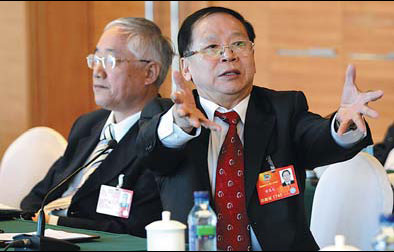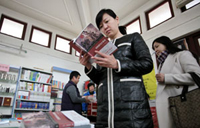Cultural regulators set to be merged
Updated: 2013-03-11 13:14
By Mei Jia and He Wei (China Daily)
|
||||||||
 |
|
Huang Changyuan, a member of the Chinese People's Political Consultative Conference, the nation's top political advisory body, attends a panel discussion during the annual session of the CPPCC in Beijing on Sunday. Zou Hong / China Daily |
The planned merger of two regulators, one on press and the other on broadcasting, announced on Sunday by State Councilor Ma Kai, will boost the development of Chinese culture and increase its global influence, officials said.
Related: Technology transforms art sharing
According to Ma's report to the annual session of the national legislature, as one part of the State Council's institutional reform, the General Administration of Press and Publication, or GAPP, and the State Administration of Radio, Film and Television, or SARFT, will be combined into one to deepen the reform of cultural institutions and optimize their resources.
|
|
| Books help turn a new page |
|
|
| Students recommend ren as message to the world |
The new State Administration of Press Publication, Radio, Film and Television will supervise the related organizations, the content and quality of their products and manage copyright, Ma said.
"The merger will ... promote Chinese culture domestically and globally," said GAPP's deputy director Wu Shulin.
Zhang Pimin, deputy director of SARFT, said the merger will help clarify the duties of different departments in the fight against crime in the cultural market.
The reform of the cultural sector started in 2003, turning hundreds of former government institutions - publishers, theaters and the like - into companies and enterprises that are operated according to market rules. The reform brings vitality to both the public cultural organizations and the cultural business.
Both press and broadcasting organizations face rising challenges from the multimedia and new media sectors, said Wang Feng, with the State Commission Office for Public Sector Reform, the main drafter of the institutional reform.
"The merger is designed to minimize the overlap of duties, increase efficiency, and better prepare the media for new challenges, with greater competitiveness," Wang said.

 'Taken 2' grabs movie box office crown
'Taken 2' grabs movie box office crown
 Rihanna's 'Diamonds' tops UK pop chart
Rihanna's 'Diamonds' tops UK pop chart
 Fans get look at vintage Rolling Stones
Fans get look at vintage Rolling Stones
 Celebrities attend Power of Women event
Celebrities attend Power of Women event
 Ang Lee breaks 'every rule' to make unlikely new Life of Pi film
Ang Lee breaks 'every rule' to make unlikely new Life of Pi film
 Rihanna almost thrown out of nightclub
Rihanna almost thrown out of nightclub
 'Dark Knight' wins weekend box office
'Dark Knight' wins weekend box office
 'Total Recall' stars gather in Beverly Hills
'Total Recall' stars gather in Beverly Hills
Most Viewed
Editor's Picks

|

|

|

|

|

|
Today's Top News
Boston bombing suspect reported cornered on boat
7.0-magnitude quake hits Sichuan
Cross-talk artist helps to spread the word
'Green' awareness levels drop in Beijing
Palace Museum spruces up
First couple on Time's list of most influential
H7N9 flu transmission studied
Trading channels 'need to broaden'
US Weekly

|

|










